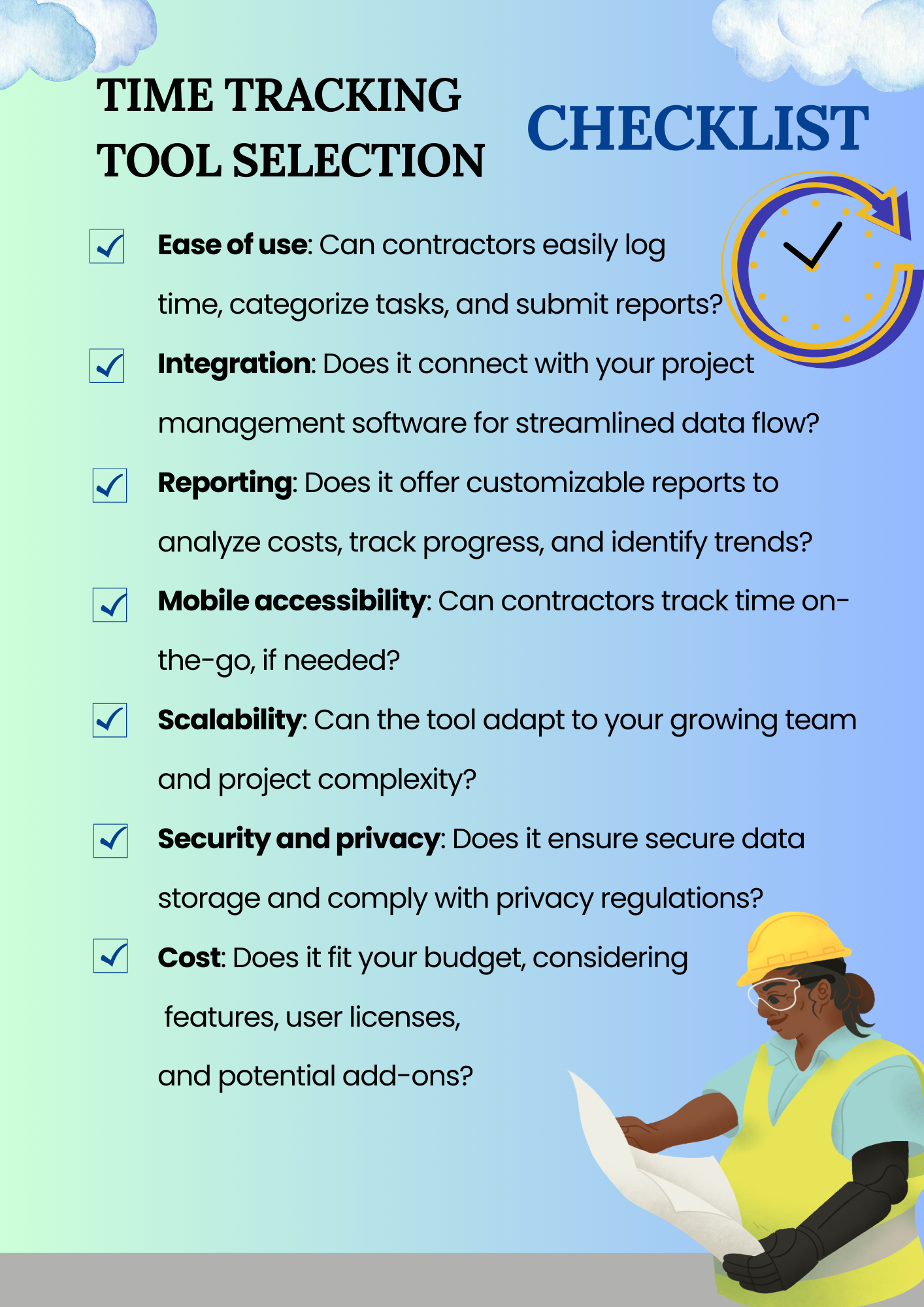How to Optimize Contractor Time Tracking for Project Success
Discover how optimizing contractor time tracking can drive project success. Learn strategies and best time tracking software for accurate time management

Optimizing contractor time tracking isn't just about paperwork; it's the bedrock of successful project outcomes.
By ensuring accurate billing, you eliminate discrepancies and build trust with clients.
It also shines a light on productivity, revealing areas for improvement and empowering contractors to improve their workflow.
How Contractor Time Tracking Fuels Proactive Project Management
Effective time tracking ultimately becomes a cornerstone of strong project management. It allows contractors to:
- forecast costs accurately
- identify and address bottlenecks early
- deliver projects on time and within budget.
Here are factors demonstrating its importance.
Forecasting and Cost Control
- Accurate Cost Estimates: Precise time data from past projects allows contractors to create realistic cost estimates for future jobs.
✅This transparency and predictability foster client trust and ensure projects stay within budget.
- Early Identification of Resource Gaps: Timely insights into resource allocation help identify potential over/understaffing situations early on.
✅This empowers proactive adjustments to schedule, budget, or team composition, preventing delays and cost overruns.
- Improved Budgeting Accuracy: Real-time expense tracking based on time spent on tasks enables contractors to adjust easily and make informed decisions throughout the project.
✅This prevents budget surprises and empowers proactive strategies to stay fiscally sound.
Enhanced Productivity and Quality
- Identifying Productivity Bottlenecks: Time tracking pinpoints tasks or processes that eat up time unnecessarily.
✅This data empowers contractors to streamline workflows, optimize resource allocation, and boost productivity.
- Data-Driven Quality Management: Tracking time spent on different quality control checkpoints permits targeted focus and improvement.
✅This data-driven approach ensures consistent quality while optimizing time invested in inspections and checks.
- Effective Client Communication: Accurate time tracking facilitates transparent communication with clients about progress, resource allocation, and potential timeline adjustments.
✅This proactive approach fosters trust and collaboration, improving project outcomes.
Risk Management and Mitigation
- Early Warning Signs of Delays: Accurate tracking reveals deviations from planned timeframes, allowing for early intervention and course correction.
✅This proactive approach mitigates delays and potential cost overruns.
- Improved Scope Management: Tracking time on specific tasks helps identify scope creep early.

✅This empowers proactive communication with clients to manage expectations, adjust deadlines, and avoid costly rework.
- Better Resource Management: Identifying underutilized resources allows for proactive redeployment to tasks requiring additional attention.
✅This optimizes resource allocation and mitigates potential risks associated with resource constraints.
🔑Accurate time tracking gives contractors the eyes and ears needed for dynamic project management.
It helps them to predict potential issues, make informed decisions, and course-correct before problems arise. This proactive approach guarantees a competitive edge in the market.
Here’s a step-by-step approach to optimizing this process, considering the complexities and dynamics of contractors' work.
Define Clear Objectives and Expectations
Before starting a project, it's essential to clearly define:
- the scope of work within a project
- the specific tasks that need to be completed.
This helps ensure that everyone involved in the project is on the same page and that the contractor's time is used efficiently. Similarly, taking the same step when implementing time tracking is crucial.
- Background Context: Before applying a time tracking system, specify what you aim to achieve with it. This could range from better project cost management to improved contractor productivity and enhanced project scheduling.
- Step-by-Step Thinking: Start by setting clear objectives for your time tracking initiative. This involves identifying the specific outcomes you want, such as increased transparency, improved billing accuracy, or better contractor workload distribution.
- Practical Steps: ✅Explain how time tracking benefits everyone involved. ✅Ensure you communicate clearly and efficiently with your contractors, suggest regular meetings or check-ins to discuss progress, address issues, and provide feedback.

Select Appropriate Time Tracking Tools
- Background Context: The market offers a myriad of time tracking tools, each with its own set of features. Choosing the right tool can significantly affect the ease with which contractors can report their hours and the accuracy of the data collected.
- Step-by-Step Thinking: Assess various time tracking tools based on criteria such as ease of use, integration with other project management software, reporting capabilities, and scalability. Consider tools that offer mobile accessibility, as contractors may be working in different locations.
- Practical Steps: ✅Research popular time tracking tools and compare their offerings. ✅Test the tools with your contractors to ensure user-friendliness.✅ Seek feedback from similar businesses. ✅Choose a tool that's intuitive and minimizes disruption to your workflow.

Best Time Tracking Apps for Contractors
TMetric
TMetric shines for its user-friendly interface and comprehensive suite of features suitable for both solo contractors and collaborative teams.
It excels in detailed time tracking, project management functionalities, and calculating billable hours, making it indispensable for accurate invoicing and productivity insights.

Toggl Track
Toggl Track is celebrated for its straightforward design and effortless one-click time tracking across different devices.
It's favored by contractors for its powerful analytics, easy integration with numerous project management applications, and its ability to offer deep insights into work patterns and efficiencies.
TimeCamp
TimeCamp is notable for its automatic time tracking feature and in-depth project management capabilities, providing contractors with essential insights into their productivity and project performance.
It features robust analytics, budget tracking, and seamless integration with a vast array of tools, aiding in a comprehensive management of work and finances.
FreshBooks
FreshBooks stands out as a cloud-based accounting solution that offers time tracking alongside its suite of invoicing and financial management tools.
It's particularly useful for contractors and small business owners needing an all-in-one solution for tracking time, managing expenses, and streamlining the billing process with customizable invoices and financial reporting.
Hubstaff
Hubstaff caters to contractors with its detailed time tracking, location monitoring, and productivity assessment tools.
Its capability to operate silently on various devices, along with automated payroll features and advanced reporting, makes it a robust solution for managing remote teams and projects efficiently, ensuring accountability and transparency.
Remember: The right time-tracking tool empowers your contractors and streamlines project management. Choose wisely for long-term success.
Implement Clear Time Tracking Policies
- Background Context: Time tracking can become inconsistent and inaccurate without clear policies. Policies should cover when and how to log time, task categorization, and handling discrepancies.
- Step-by-Step Thinking: Develop comprehensive time tracking policies that are communicated clearly to all contractors. These policies should include deadlines for submitting time, the level of detail required in time entries, and guidelines for categorizing tasks. Regular training sessions can ensure that contractors understand these policies.
- Practical Steps:✅Establish clear deadlines for timesheet submission and late submission protocols. ✅Define the level of detail needed in time entries (descriptions, durations, justifications)✅ Set a protocol for addressing discrepancies in time sheets and offer support for accurate logging✅ Consider variations for hourly vs. fixed-fee contractors or specific project requirements.
✅Adapt policies based on feedback, changes in workflow, and evolving industry standards✅Ensure internal teams also follow time tracking policies for consistency and fairness✅Acknowledge contractors who consistently follow policies and contribute to accurate time tracking.
Ensure Easy Integration with Other Systems
- Background Context: Time tracking systems should not operate in isolation. They must integrate seamlessly with other project management, billing, and payroll systems to streamline processes and improve efficiency.
- Step-by-Step Thinking: This integration facilitates real-time data transfer, reduces manual data entry, helps gain up-to-date insights on project progress and costs.
- Practical Steps:✅ Identify project management, billing, payroll, and any other relevant software tools used in your workflow. ✅Select a time tracking tool that automatically generates invoices and payroll calculations because it reduces errors and improves overall project management efficiency.
Regular Review and Feedback Loops
- Background Context: The effectiveness of a time tracking system should be evaluated regularly.
- Step-by-Step Thinking: When organizing a review stage, you aim to identify issues or inefficiencies.
- Practical Steps:✅ Schedule regular reviews of the time tracking process, involving both project managers and contractors. ✅Use these sessions to gather feedback and identify challenges. ✅Adjust time tracking policies, tools, or integration based on identified gaps and feedback. ✅Share review findings and implemented changes with all stakeholders for clear communication and buy-in.
Use Data for Project Management Insights
- Background Context: The data collected through time tracking is a valuable resource for project management.
- Step-by-Step Thinking: Search for insights into project progress, contractor productivity, and areas where efficiencies can be gained.
- Practical Steps:✅ Identify tasks with consistently longer durations, resource bottlenecks, or significant variations in time estimates. ✅Assess individual and team productivity, identify time management challenges, and recognize high performers✅ Utilize charts, graphs, and dashboards to present data insights in an easily digestible format✅ Use these insights to adjust project timelines, reallocate resources, or provide targeted training and support to contractors✅Utilize charts, graphs, and dashboards to present data insights in an easily digestible format, and leverage historical data to set more accurate timelines for future projects.
Conclusion
Time tracking for contractors is not just about administrative efficiency; it's vital for ensuring project success and building client trust.
By closely monitoring and analyzing worker hours, projects can identify areas of inefficiency and make data-driven decisions to improve productivity and cost management.
This leads to better project outcomes, with increased transparency and reliability that strengthens client relationships.
In today's competitive construction industry, integrating effective time tracking practices into project management is practically a must-have for achieving operational excellence, fostering strong partnerships, and securing a competitive advantage in the dynamic construction industry.
Stop wasting time on manual timesheets. TMetric automates tracking and boosts your team's efficiency.


